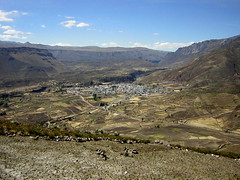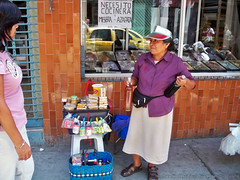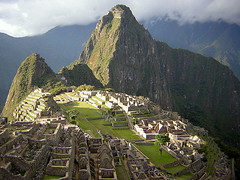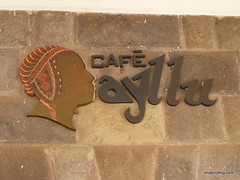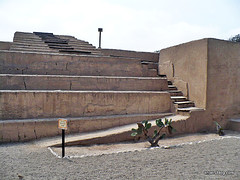Huarco temple complex of Vilcahuasi
I couldn’t believe what I was seeing when I finally looked out around me from atop the huge mound of sand I had just climbed. What I was standing on was clearly the remains of an ancient pyramid, and next to it was another and another and another after that. I counted twelve in total.
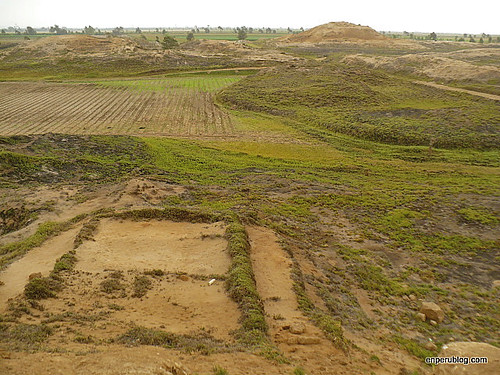
Pyramids across the fields
I could see there was a larger one in the near distance, perhaps the second largest of the group. In front of it was a perfectly laid out square, now converted into a field by local farmers. It is a lot the perfect square plazas found in the 3000-or-so-year-old U-shaped temples closer to Lima, but this didn’t have two additional pyramids on either side of the square. And these pyramids weren’t nearly as old.
I was deep inside what was once ancient Guarco territory, a territory dominated by this culture until the arrival of the Inca armies in the 1400s. Surrounding me were a series of temples located out in the middle of a fertile area without strategic defensive planning, safe within a nation state with well protected borders. The Guarco, or Huarco, were eventually subdued by the Incas, and that is perhaps why the little-explored, unstudied and forgotten archaeological site is called by a Quechua name Vilcahuasi – “Sacred House” or maybe less literally translated “home of the sacred”.
The once firm adobe pyramids had long since dissolved into powdery sand, and I was careful to remain in the footsteps of local farmers who had passed through here before me. To the the left and right of the trails, bits of which would once have been through grand passageways and up steps to the temples’ peaks, were scattered pieces of broken pottery, both decorated and simple. Among them, pieces of ancient textiles flapped in the light breeze coming from the not too distance sea.
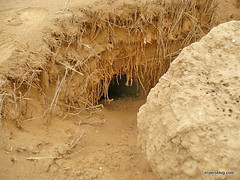
Robbed grave
This place, once the holiest of holy sites for the Guarco while both a free people and as Inca subjects, would once have been the focal point for people living in this valley, it would have been a revered religious centre. Today though it has been forgotten by everyone, even it seems, by grave robbers. I counted no more than three holes dug into the pyramid with an obvious aim to remove possible mummies. This is a shockingly small number for Peru, and one that left me wondering what other priceless treasures were still to be found beneath my feet, perhaps buried with the body of an elite of Guarco society or left as offerings to the gods.
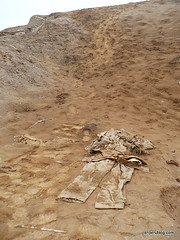
Old uniform
I am transported of the more recent past when I stumbled upon a less ancient artefact. A local woman had told me that just months ago a representative from the Government had visited these fields, hoping to catalogue the ruins. It was he that first stumbled upon the object – what appeared to be a old and faded army uniform. Was this left here by advancing Chilean soldiers? It wasn’t buried with a fallen Peruvian – there was nothing else around, no bones, nothing. Why would someone bury a uniform? Unfortunately neither he nor I could tell from what country or time period it belonged to, and the colour had completely faded away along with any hope for a non-expert to make any identification.
Down now, and behind another great towering structure, there was finally, and sadly, evidence of modern and thoughtless Peru. In a pit, garbage had been dumped. From tin cans to plastic bottles, the staggering disrespect that Peruvians have for their heritage doesn’t seem to have any limits. I wonder, as with the majority of ancient sites in Peru, if one day Vilcahuasi will be studied and saved by a foreign professor of archaeology rather than a by Peruvian. It often takes a foreigner to point out to Peruvians the importance of their history, and to foreigners and their investments to protect Peruvian sites from decay and intentional destruction. Hopefully this will start to change.
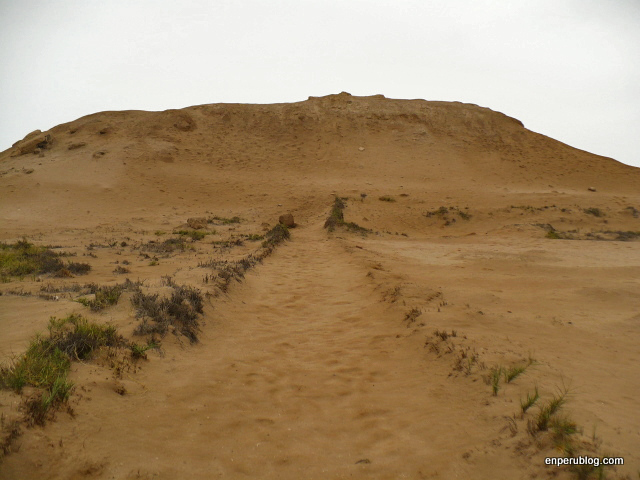
Entrance and hallway
In front of what must have been the main pyramid I suddenly feel very lucky. Stretching out before me is what would have been a grand passageway leading to the foot of the pyramid where stairs would have taken you to the very top. I feel lucky because the likes of me would probably not have been allowed to set foot inside this structure 500 years ago – thankfully their are no Huarco guards to keep this commoner out.
As I walk along the imposing hallway I imagine the how the walls would have looked, towering over me all those centuries ago. Were they decorated with shapes? Where they brightly painted as were all adobe structures of that time?
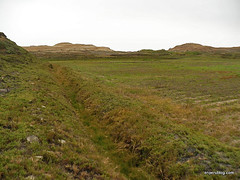
Egde of the square
Earlier I had approached the pyramid with the huge square plaza in front of it head on, having already stood in the middle of what was now a ploughed square field with planted crops. This was when I first noticed that all the shrubs that had begun to grow on the slopes of the decayed pyramids had spider webs strung between them with some worrysome looking arachnids on them. I had until that point only been preoccupied with snakes. One hour’s walk back to the Panamerican Highway with a neurotoxin in my bloodstream didn’t sound like fun, so I was being careful to stay out in the open. But here, were I was now, on the other side of the huge complex that you could very easily call a city, something called my attention across the shrubbery.
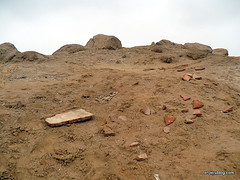
Ceramic pottery
It was one of the few attempts at grave robbing. A hole had been dug and something large extracted. Nearby were the remains of a huge piece of pottery. It was broken into many pieces, but one section was still well intact. I gathered that the pot must have been at least 80cm tall. Also nearby was another interesting feature – a thick wooden pole poking out of the top of the pyramid. Was this a Guarco wooden post, or something more recent? In other ancient sites on the coast of the same period, such wooden posts on the tops of adobe pyramids meant one thing… seasonal calendars – at least that’s what archaeologists think. In an ancient Andean world where science and religion were so intertwined, it would make sense that this important device would be found here in the culture’s religious centre. These calenders told the people when to dedicate their time to fishing and when to concentrate on farming.
Walking around a small group of structures, I find myself two metres up from the ground on the north western side of the grand city of Vilcashuasi. As it probably was 500 years ago, the surrounding area is farmland. Untouched by the farmers, dotted here and there, are a few small structures. Pyramidal in shape, they look like miniature versions of the others, these being only 5×5 metres or so. Were these simple shrines and alters?
Heading back, I look behind me one last time. I feel privileged to be among the few who have acknowledged this ancient holy city’s existence, but glad that it hasn’t been completely pillaged by grave robbers. Hopefully it will eventually gain the attention of archaeologists, giving us insight into the customs and beliefs of the people who ruled the Cañete valley. Maybe even one day this place can be returned to its former glory, its shifting sands reset into firm adobe blocks that could last out another 500 years.
More Photos



